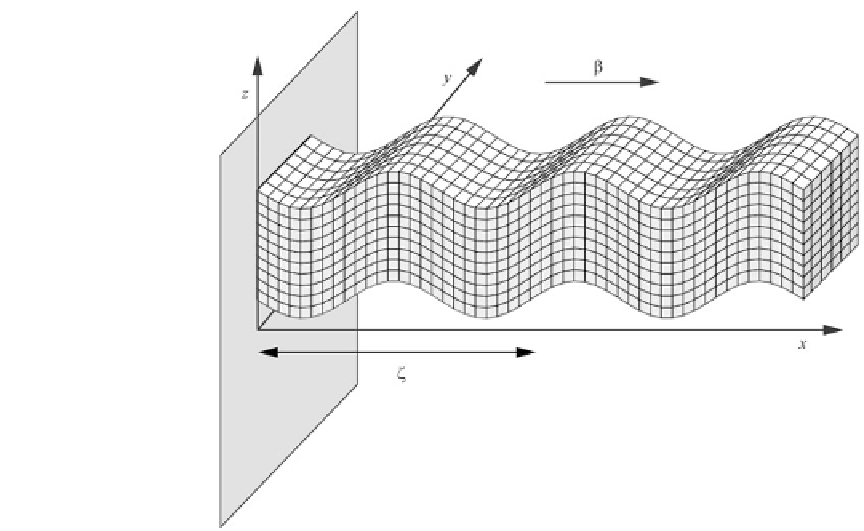Geology Reference
In-Depth Information
Fig. 8.3
Pattern of
deformation associated
with the propagation of
S
waves
In the case of a plane wave that is propagating
in the
x
direction, we have that:
3
10
10
Pa and density ¡
D
3
10
3
Kg/m
3
.
In this instance, we have average velocities
'
5.5 km s
1
and “
3.2 km s
1
. The trends
of the seismic velocities and the density in the
PREM
(Preliminary Reference Earth Model,
Dziewonski and Anderson
1981
) global seismic
model of the Earth are illustrated in Figs.
8.4
and
8.5
. We note an approximately linear
increase of ', “,and¡ in the lower mantle,
with gradients: @'/@
z
D
1.35
˙
0.04 m s
1
km
1
,
@“/@
z
D
0.56
˙
0.03 m s
1
km
1
,and@¡/@
z
D
0.54
˙
0.01 kg m
3
km
1
, and a roughly linear
increase in the transition zone, with higher
gradients: @'/@
z
D
4.47
˙
0.48 m s
1
km
1
,
@“/@
z
D
2.52
˙
0.29 m s
1
km
1
,and@¡/@
z
D
1.07
˙
0.14 kg m
3
km
1
. Conversely, the trend
is discontinuous in the asthenosphere. The linear
increase in the lower mantle and in the transition
zone is in agreement with what we expect from
the changes in pressure and temperature on rocks
of uniform composition and crystal structure. We
also note the dramatic
5.7 km s
1
drop of ' at
the CMB, which accompanies the disappearance
of
S
waves in the liquid external core. Another
important discontinuity for ', “,and¡ is the
inner-core boundary (ICB) at
5,150 km, which
separates the liquid external core from the solid
iron internal core (Figs.
8.4
and
8.5
).
i
D
i
t
x
“
@
u
k
@x
j
D
f
i
.x/ (8.29)
D
©
ijk
Therefore, as for
P
waves, the derivatives
of displacement components in the
y
and
z
di-
rections must be zero, because otherwise the
displacement would increase or decrease indefi-
nitely:
@
u
y
@
z
D
0
@
u
z
@y
D
Consequently,
x
D
0and
u
lies in the
yz
plane
(
u
x
D
0). These waves are said
transverse waves
,
to express the fact that displacements always
occur in a direction normal to the propagation
direction, as illustrated in the example of Fig.
8.3
.
When the displacement occurs along the
z
axis,
we say that the wave is polarized vertically
(
SV waves
,Fig.
8.3
), while for a motion in
the
y
direction, parallel to the Earth's surface,
we say that the wave is polarized horizontally
(
SH waves
). The typical velocities of
P
and
S
waves in the crust are easily calculated assuming
that the crust is a Poisson solid with
D
œ


